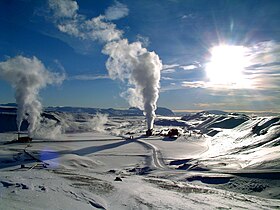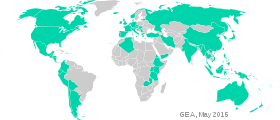
Back Geotermiese krag Afrikaans كهرباء حرارية أرضية Arabic ভূতাপীয় শক্তি Assamese ভূ-তাপীয় বিদ্যুৎশক্তি Bengali/Bangla الکتریسیته زمینگرمایی Persian 地熱発電 Japanese Jiotoermal ilekchrixiti JAM 지열 발전 Korean ഭൗമ താപോർജ്ജം Malayalam د ځمکې تودوخې طاقت Pashto/Pushto
| Part of a series on |
| Sustainable energy |
|---|
 |
Geothermal power is electrical power generated from geothermal energy. Technologies in use include dry steam power stations, flash steam power stations and binary cycle power stations. Geothermal electricity generation is currently used in 26 countries,[1][2] while geothermal heating is in use in 70 countries.[3]
As of 2019, worldwide geothermal power capacity amounts to 15.4 gigawatts (GW), of which 23.9% (3.68 GW) are installed in the United States.[4] International markets grew at an average annual rate of 5 percent over the three years to 2015, and global geothermal power capacity is expected to reach 14.5–17.6 GW by 2020.[5] Based on current geologic knowledge and technology the Geothermal Energy Association (GEA) publicly discloses, the GEA estimates that only 6.9% of total global potential has been tapped so far, while the IPCC reported geothermal power potential to be in the range of 35 GW to 2 TW.[3] Countries generating more than 15 percent of their electricity from geothermal sources include El Salvador, Kenya, the Philippines, Iceland, New Zealand,[6] and Costa Rica. Indonesia has an estimated potential of 29 GW of geothermal energy resources, the largest in the world; in 2017, its installed capacity was 1.8 GW.
Geothermal power is considered to be a sustainable, renewable source of energy because the heat extraction is small compared with the Earth's heat content.[7] The greenhouse gas emissions of geothermal electric stations average 45 grams of carbon dioxide per kilowatt-hour of electricity, or less than 5% of those of conventional coal-fired plants.[8]
As a source of renewable energy for both power and heating, geothermal has the potential to meet 3 to 5% of global demand by 2050. With economic incentives, it is estimated that by 2100 it will be possible to meet 10% of global demand with geothermal power.[6]
- ^ Geothermal Energy Association. Geothermal Energy: International Market Update Archived 25 May 2017 at the Wayback Machine May 2010, p. 4-6.
- ^ Bassam, Nasir El; Maegaard, Preben; Schlichting, Marcia (2013). Distributed Renewable Energies for Off-Grid Communities: Strategies and Technologies Toward Achieving Sustainability in Energy Generation and Supply. Newnes. p. 187. ISBN 978-0-12-397178-4. Archived from the original on 11 May 2021. Retrieved 25 October 2020.
- ^ a b Cite error: The named reference
IPCCwas invoked but never defined (see the help page). - ^ Richter, Alexander (27 January 2020). "The Top 10 Geothermal Countries 2019 – based on installed generation capacity (MWe)". Think GeoEnergy - Geothermal Energy News. Archived from the original on 26 January 2021. Retrieved 19 February 2021.
- ^ "The International Geothermal Market At a Glance – May 2015" (PDF). GEA—Geothermal Energy Association. May 2015. Archived (PDF) from the original on 6 October 2021. Retrieved 23 November 2021.
- ^ a b Craig, William; Gavin, Kenneth (2018). Geothermal Energy, Heat Exchange Systems and Energy Piles. London: ICE Publishing. pp. 41–42. ISBN 9780727763983. Archived from the original on 21 August 2018. Retrieved 21 August 2018.
- ^ Cite error: The named reference
sustainabilitywas invoked but never defined (see the help page). - ^ Moomaw, W., P. Burgherr, G. Heath, M. Lenzen, J. Nyboer, A. Verbruggen, 2011: Annex II: Methodology. In IPCC: Special Report on Renewable Energy Sources and Climate Change Mitigation (ref. page 10) Archived 27 June 2013 at the Wayback Machine

